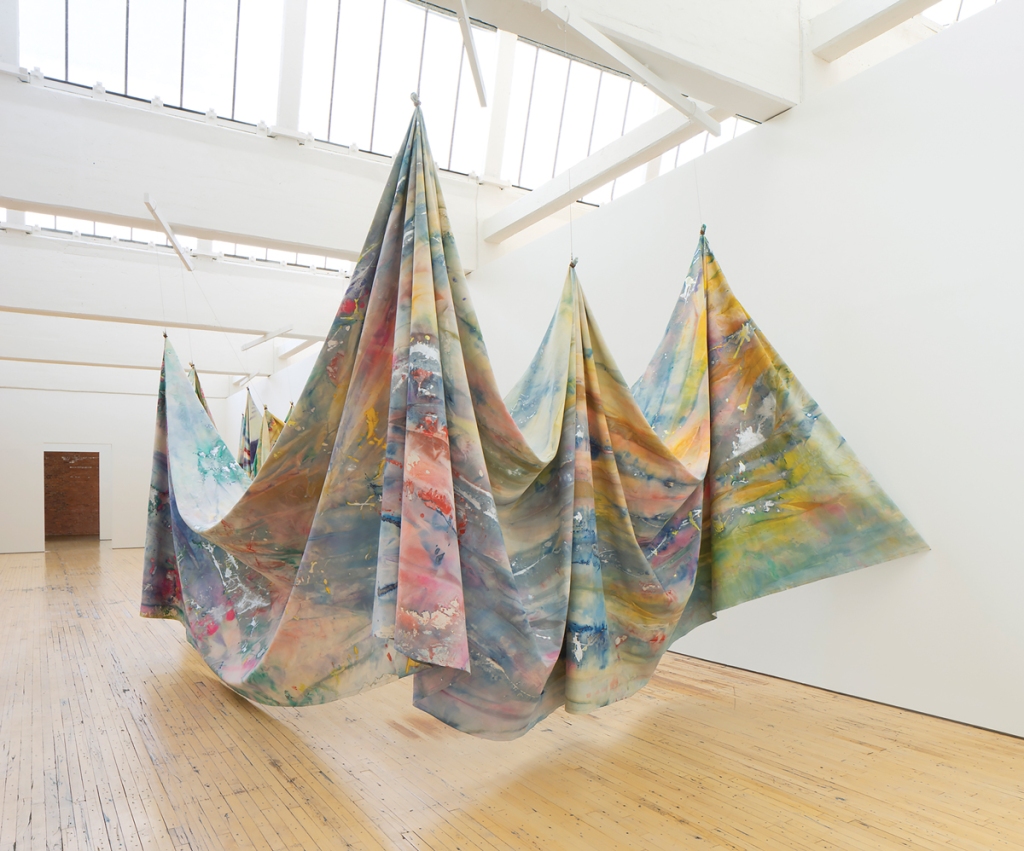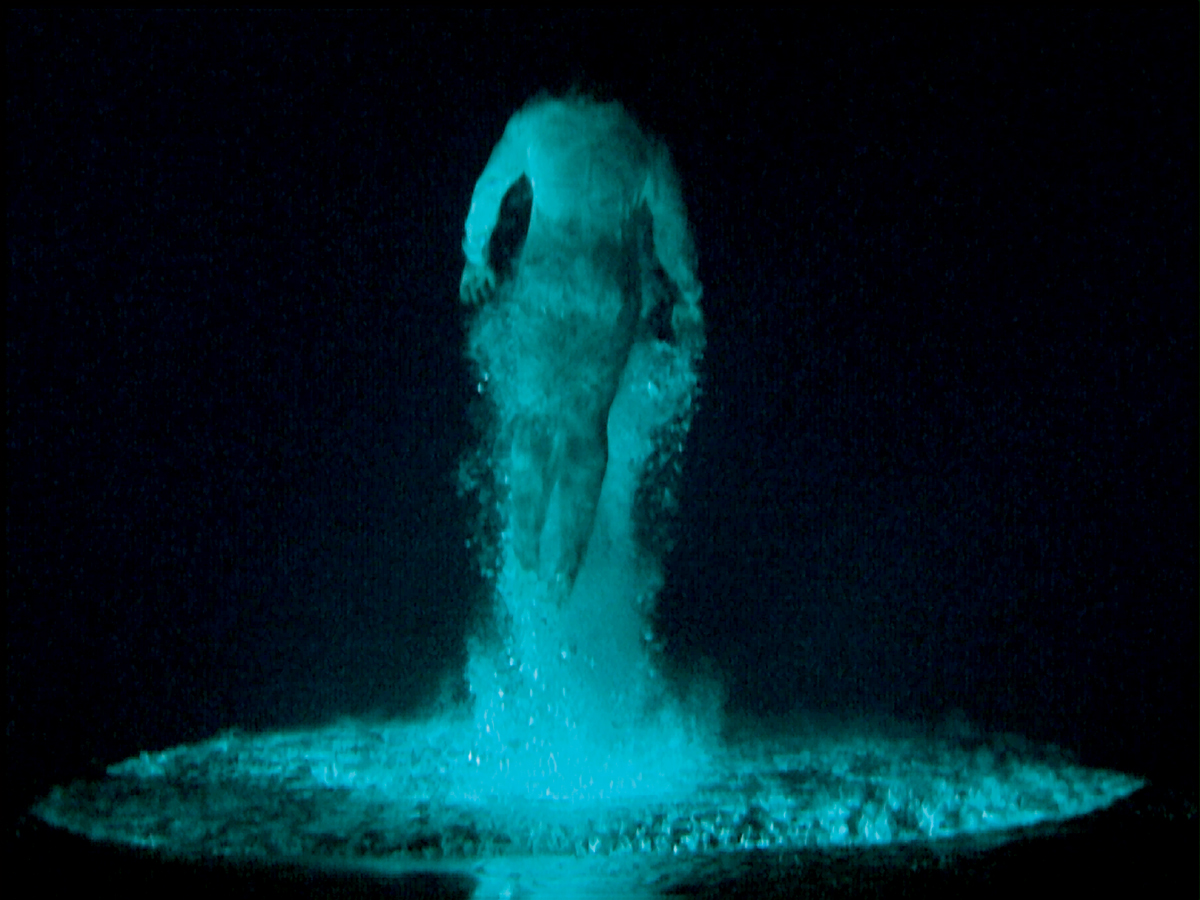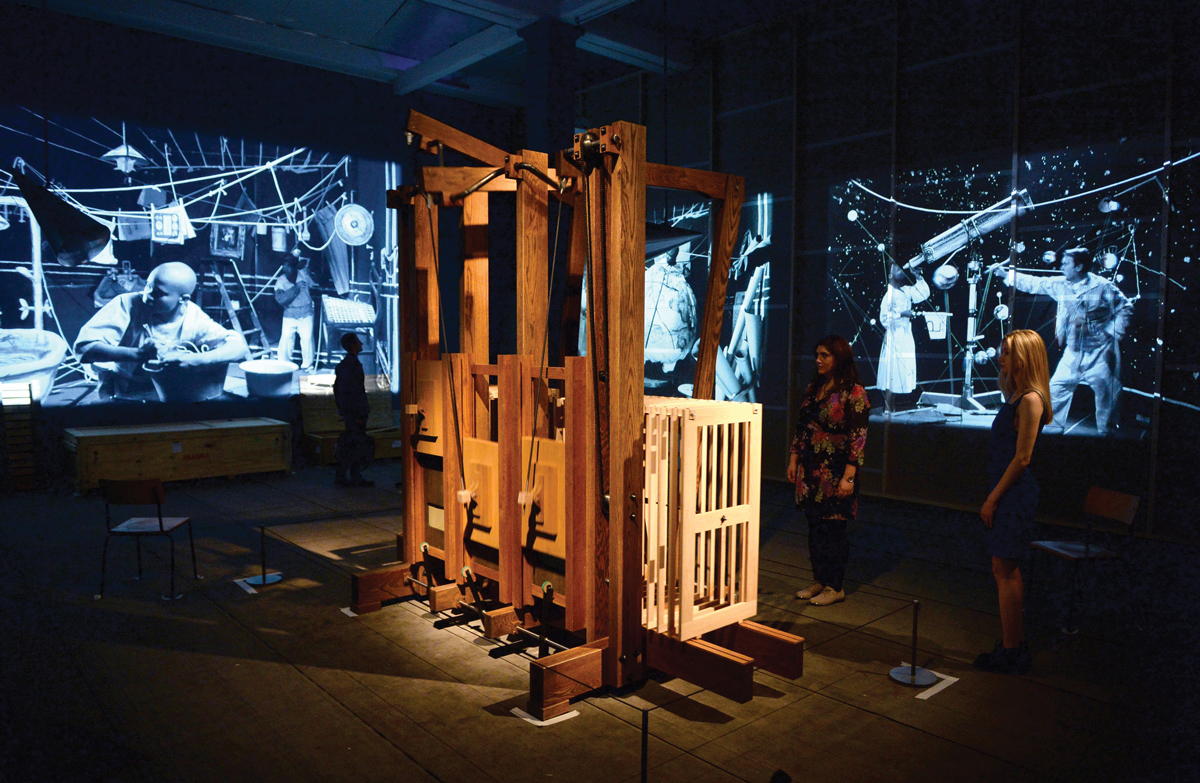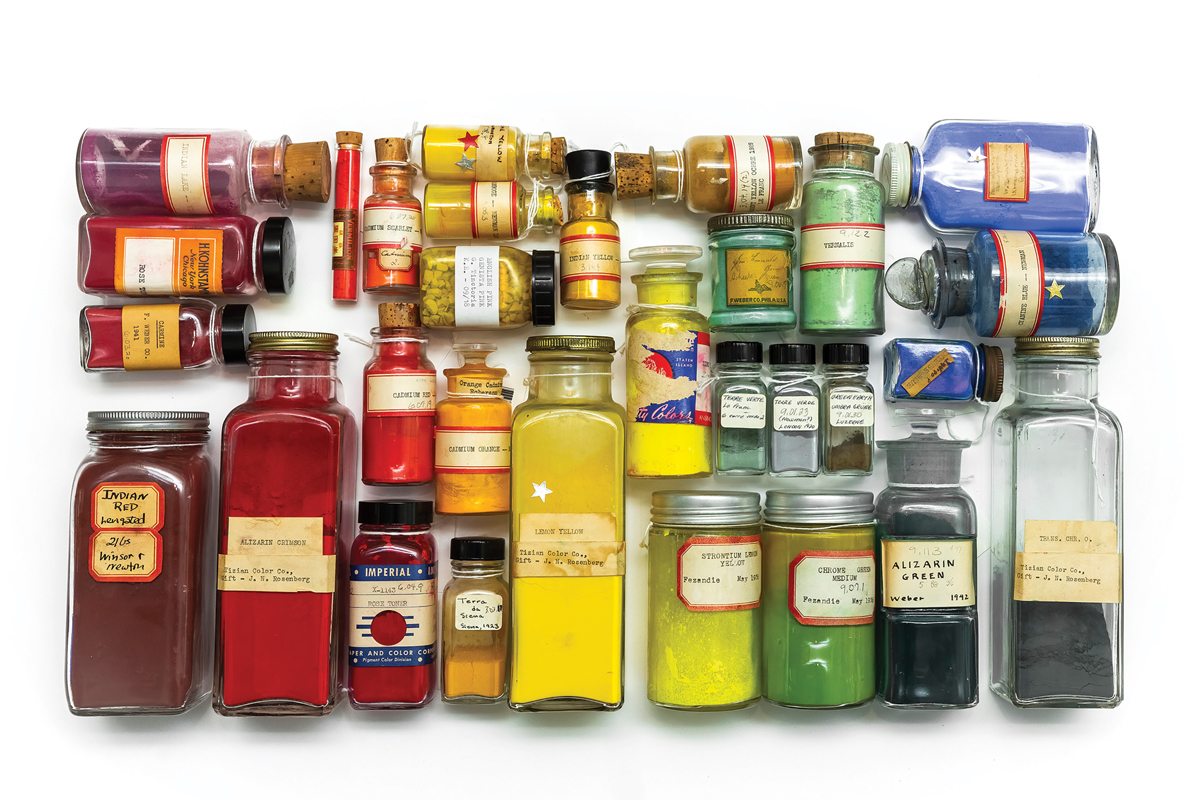 Earlier this year, the Dia Art Foundation and the Museum of Fine Arts, Houston jointly acquired Sam Gilliam’s enormous sculptural painting Double Merge (1968), shown here on view at Dia:Beacon. Photo Bill Jacobson Studio, New York/©Sam Gilliam/Artists Rights Society (ARS), New York
Earlier this year, the Dia Art Foundation and the Museum of Fine Arts, Houston jointly acquired Sam Gilliam’s enormous sculptural painting Double Merge (1968), shown here on view at Dia:Beacon. Photo Bill Jacobson Studio, New York/©Sam Gilliam/Artists Rights Society (ARS), New York
It didn’t take long for visitors to Dia:Beacon to fall for Sam Gilliam’s vibrantly colored abstract painting Double Merge (1968), an enormous canvas cascading from the ceiling, when it went on display two years ago, on long-term loan from a private collector. “It is beloved by our audience,” said the museum’s head, Dia Art Foundation director Jessica Morgan, who herself was taken with the piece. “I think with so many things in Dia:Beacon, once you install them you realize all the ways in which they’re opening doors and avenues for potential within the collection, and witnessing relationships between works that you hadn’t imagined were there before,” she said. “It just became even more urgent for us to think about how we could bring this work into the collection.” Gilliam’s work has soared into the millions over the past few years, pricing out most museums, with their modest budgets. This past March, however, came a surprising announcement: Dia had acquired the work—with an interesting twist: it was to be a joint acquisition with an institution nearly 1,700 miles away, the Museum of Fine Arts, Houston (MFAH). Double Merge will travel to Houston next year, and in five years, it will be back in Beacon.
The past year has been difficult for museums, many of them facing financial hardship even before the pandemic brought monthslong closures and layoffs. A survey published by the American Alliance of Museums in June estimated that it will take “years” for United States art institutions to recover from the fallout of the global health crisis; it also revealed that 56 percent of museums issued furloughs or layoffs since March 2020.
At the same time, museums are feeling an urgent need to diversify their holdings to make them better reflect the full scope of art history, by acquiring works by women artists and artists of color. Many of those same artists, however, like Gilliam, have become the subject of heated competition between private collectors eager to buy. “It is becoming somewhat unfeasible for a lot of institutions to acquire major works, as prices are reaching levels that only certain private collectors are able to respond to,” said Morgan. Some institutions have turned to deaccessioning, like the San Francisco Museum of Modern Art, which sold a Mark Rothko in 2019 in order to buy pieces by Mickalene Thomas, Frank Bowling, Leonora Carrington, and others. If museums can get over some logistical issues, joint acquisitions may be one way for them to add new works to their collections, even as they stay within straitened budgets.
 In 2003 the Whitney Museum of American Art in New York; Tate, London; and the Centre Pompidou in Paris jointly acquired Bill Viola’s 2001 three-channel video installation Five Angels for the Millennium. Photo Kira Perov/©Bill Viola Studio
In 2003 the Whitney Museum of American Art in New York; Tate, London; and the Centre Pompidou in Paris jointly acquired Bill Viola’s 2001 three-channel video installation Five Angels for the Millennium. Photo Kira Perov/©Bill Viola Studio
“I think co-ownership is great,” MFAH director Gary Tinterow said. “There’s a whole lot of art to go around. We are all suffering from insufficient storage and we are all finding our display spaces continually under pressure.” Art institutions must “provide for the public the richest, the best, the most diverse, the most exciting visual experience,” he said. “That’s our job. And one way to do that is to own works of art. Another way to do it is to borrow works of art. Another way to do it is [to] jointly own works of art.” Double Merge, he said, “is one of the most notable among the [museum’s] efforts” to acquire more works by Black artists.
“It seems like a great way forward for all our institutions,” Morgan said. “At the heart of it is the benefit of being able to see the work, and I think we’re all distressed when we think about all the works that are never put on view for one reason or another. This seems like, in many ways, a forward-thinking move and it definitely feels like the future of collection building.”
 Another important Sam Gilliam painting, Arc II, from 1970, which the Museum of Fine Arts, Houston acquired on its own, in addition to Double Merge. ©2021 Sam Gilliam/Artists Rights Society (ARS), New York
Another important Sam Gilliam painting, Arc II, from 1970, which the Museum of Fine Arts, Houston acquired on its own, in addition to Double Merge. ©2021 Sam Gilliam/Artists Rights Society (ARS), New York
While the roots for joint acquisitions go back as far as the early 20th-century practice of partage, which established a precedent for shared ownership of finds from archaeological research, the practice as applied to modern and contemporary art is more recent, and in the 21st century it has even extended to international collaborations. The earliest such instance was the 2003 shared acquisition of Bill Viola’s 2001 video installation Five Angels for the Millennium by the Whitney Museum of American Art in New York; Tate, London; and the Centre Pompidou in Paris, initiated by Maxwell Anderson, then director of the Whitney. The benefits were twofold: the European museums, which did not have the same private sector support as American art institutions, could more easily acquire the artwork as part of a group; all three institutions were helped by sharing the costs associated with the care and storage of such a large-scale installation.
“That was a watershed for New York museums because it presaged an opportunity—particularly for works that are highly complex or large-scale or require a lot of time and attention to install—to have shared ownership,” Anderson said of the three-way acquisition. “I was looking at it as a model going forward for room-size installations that otherwise might not make it into museum collections.”
While it may, on the surface, seem complicated, “shared ownership,” Anderson said, “is no more onerous than all the other types of quietly signed and grudgingly agreed-to agreements that pepper art museums across the country. Keeping track of those is a full-time job for the registration department.” Still, since the Viola, he said, “we’ve seen some efforts to do this, but it hasn’t taken off. I think a lot of that is a function of the territoriality that is natural to the art world.” As Tinterow sees it, “the fundamental obstacle for some institutions is control,” and, given that no participant in a joint acquisition has the unilateral power to sell or display a work at will, relinquishing unrestricted ownership can turn museums off. (At the time of the Viola acquisition, Kathy Halbreich, then director of the Walker Art Center in Minneapolis, told the New York Times, “these days none of us can afford to go it alone,” adding, “we just have to park our egos outside the door.”)
“The whole premise of permanent collections is under scrutiny these days.’’
Other deterrents to such agreements between institutions are often of a practical nature. As any insurance company will tell you, the more times you transport a complex work like Gilliam’s Double Merge—or, really, any piece that isn’t digital—you incur risk. There are also issues related to conservation, storage, loan applications, and legal intricacies to work out between participating institutions. Paul Martineau, associate curator in the photography department at the Getty Museum in Los Angeles, which entered into a joint acquisition with the Los Angeles County Museum of Art in 2011 to add more than 2,000 works by Robert Mapplethorpe to its collection, said that joint acquisitions make sense for institutions looking to buy a work that is “just completely out of reach, but otherwise it can be logistically difficult,” he said. “And sometimes that weighs against a collaboration.”
Writer and adviser to cultural institutions András Szántó attributes the relative infrequency of joint acquisitions in part to the fact that museums are not set up to co-own works. Szántó said that there are “huge advantages” to the practice, given that most institutions have “severe limitations not just in their budgets but also in their ability to display and store and care for works.”
“There are very well-established mechanisms for loaning works and touring exhibitions, but this practice [of jointly acquiring works] is still rather new, and museums are not that accustomed to experimenting with new ways,” he said. “For museums, anything that doesn’t fit neatly into the existing mechanisms or categories is going to be a challenge. I think collaboration in general falls into an area that everybody would agree is a good idea, but when it comes to the nuts and bolts it’s complicated to do—so that creates a disincentive to do it.”
 The Metropolitan Museum of Art in New York and the San Francisco Museum of Modern Art jointly acquired William Kentridge’s multimedia installation The Refusal of Time (2012), above, in 2013. AP Photo/Doug Peters
The Metropolitan Museum of Art in New York and the San Francisco Museum of Modern Art jointly acquired William Kentridge’s multimedia installation The Refusal of Time (2012), above, in 2013. AP Photo/Doug Peters
Despite drawbacks that may be keeping the practice from becoming a norm for museums, the last decade has seen joint acquisitions of various kinds of works. In 2013 the Metropolitan Museum of Art in New York and the San Francisco Museum of Modern Art jointly acquired William Kentridge’s multimedia installation The Refusal of Time (2012), and in 2016 SFMOMA and the Dallas Museum of Art joined forces to purchase Walter De Maria’s 1986 sculpture Large Rod Series: Circle/Rectangle, 5, 7, 9, 11, 13.
And such acquisitions have not been limited to artworks. In 2020 the Harvard Art Museums in Cambridge, Massachusetts, and the Georgia O’Keeffe Museum in Santa Fe, New Mexico, together acquired a group of 20 pigments—including shades of burnt sienna and indigo—that O’Keeffe used. The institutions bought the pigments at Sotheby’s New York last spring for around $56,000, and Narayan Khandekar, director of the Straus Center for Conservation and Technical Studies and senior conservation scientist at the Harvard Art Museums, said they will help art professionals better understand how O’Keeffe worked.
 Georgia O’Keeffe used a wooden crate to store her pigments, which have been jointly acquired by the O’Keeffe Museum and Harvard. Shown here, a selection from the Forbes Pigment Collection at Harvard. Photo Caitlin Cunningham/©President and Fellows of Harvard College
Georgia O’Keeffe used a wooden crate to store her pigments, which have been jointly acquired by the O’Keeffe Museum and Harvard. Shown here, a selection from the Forbes Pigment Collection at Harvard. Photo Caitlin Cunningham/©President and Fellows of Harvard College
The pigments will be part of a collaborative research effort between the two museums, which will use small samples of the materials for scientific study. Khandekar likened the agreement with the O’Keeffe Museum to “shared custody,” and the steward of the pigments will depend on which institution has them at what time.
Other agreements are more time specific. Double Merge, for instance, will move between the Dia and MFAH every five years. The museum in possession of the work insures it, and decides when to exhibit it and for how long. But getting any further into the weeds, time-wise, doesn’t seem worth, it, Khandekar said. “I think in many ways if you have to get down to the nuts and bolts of the number of days and hours, then it’s not so much a collaboration as a legal agreement.” With the pigments, he said, Harvard and the O’Keeffe Museum are striving to cultivate a “nice, generous approach to having joint ownership.”
“What’s interesting to me,” he continued, “is the amount of attention that came from buying jars of pigment. The fact that people are interested in that is good news to us. It tells us that we’re doing something that’s interesting to the public.”
It remains an open question whether joint acquisitions will catch on more widely in the art world as museums start to navigate the post-Covid landscape. Phenomena like the recent NFT craze and the rise in popularity of immersive experiences like Yayoi Kusama’s “Infinity Mirror Room” installations and van Gogh digital projections may change the way museums think about investing in and building permanent collections of objects, Anderson said.
“I think the whole premise of permanent collections is under scrutiny these days in that the public seems to be responding as much to temporary experiences and events,” he said. “These are things that seem to be driving attention. There is a bit of questioning about the degree to which permanent collection growth is still the mark of institutional heft and value.”
 In 2016, SFMOMA and the Dallas Museum of Art teamed up to buy Walter De Maria’s 1986 sculpture Large Rod Series Circle/Rectangle 5, 7, 9, 11, 13. Courtesy Dallas Museum of Art/©Estate of Walter De Maria
In 2016, SFMOMA and the Dallas Museum of Art teamed up to buy Walter De Maria’s 1986 sculpture Large Rod Series Circle/Rectangle 5, 7, 9, 11, 13. Courtesy Dallas Museum of Art/©Estate of Walter De Maria
Szántó pointed out that the art world is home to a “systemic desire to collaborate, but there’s very little actual evidence of it,” even in the aftermath of a once-in-a-century global crisis.
“I think it’s early days, but it will be interesting to see, as new financial technologies begin to infiltrate the art world and the museum world, whether they create new platforms or frameworks to facilitate this kind of sharing of the burdens of ownership between museums and also potentially other partners,” Szántó concluded.
In the meantime, there is another benefit to the joint acquisition: more people, in different regions, will get to see the work. “This is an incredibly important work,” said Morgan of the Gilliam piece. “And it would be better for it to be shown in multiple locations rather than just one.”
A version of this article appears in the August/September 2021 issue of ARTnews, under the title “Share and Share Alike.”
Source link : https://www.artnews.com/art-news/news/art-museum-joint-acquisitions-collaborations-1234604356












